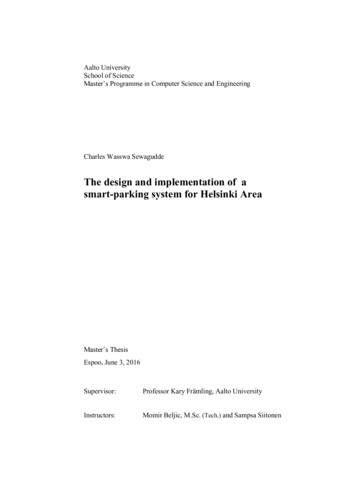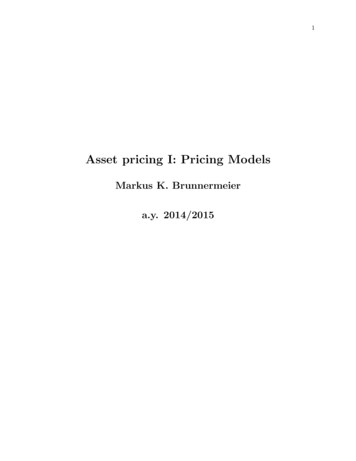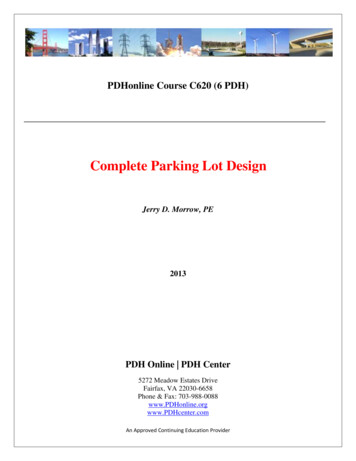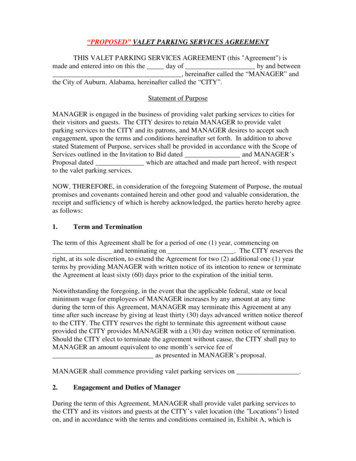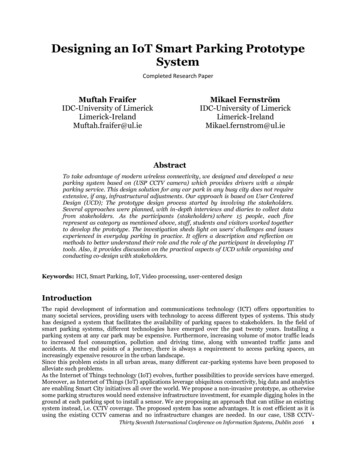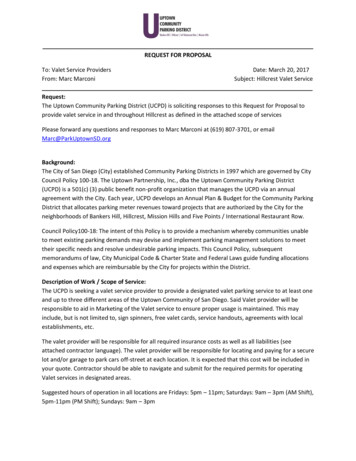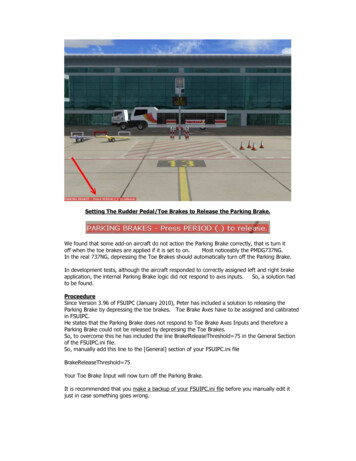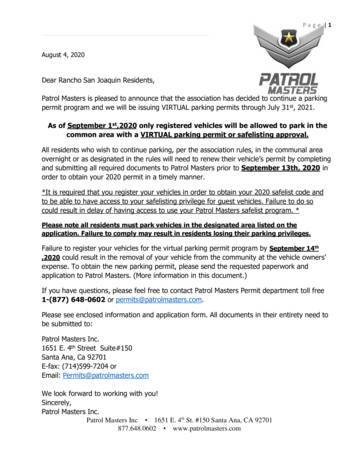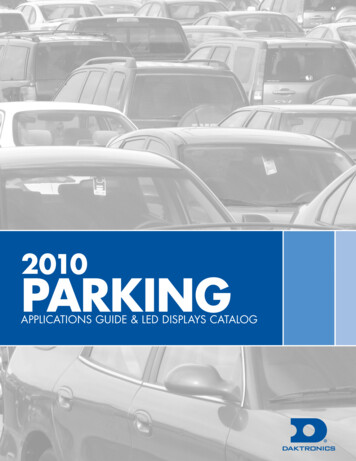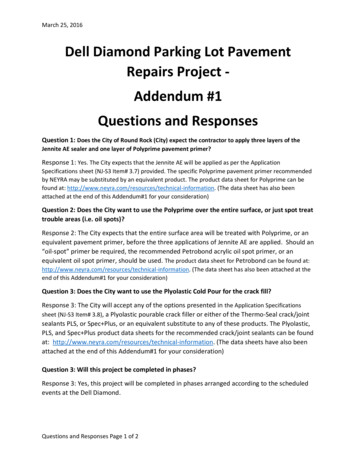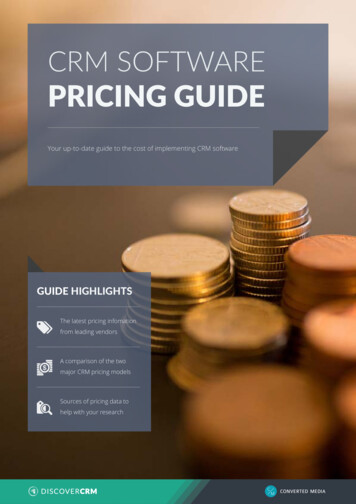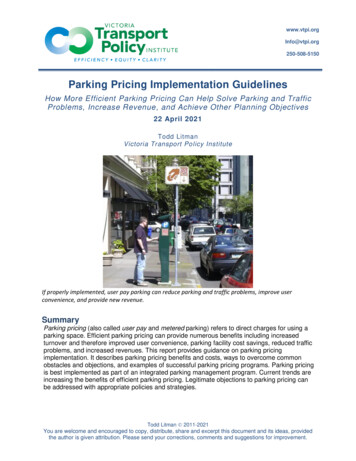
Transcription
www.vtpi.orgInfo@vtpi.org250-508-5150Parking Pricing Implementation GuidelinesHow More Efficient Parking Pricing Can Help Solve Parking and TrafficProblems, Increase Revenue, and Achieve Other Planning Objectives22 April 2021Todd LitmanVictoria Transport Policy InstituteIf properly implemented, user pay parking can reduce parking and traffic problems, improve userconvenience, and provide new revenue.SummaryParking pricing (also called user pay and metered parking) refers to direct charges for using aparking space. Efficient parking pricing can provide numerous benefits including increasedturnover and therefore improved user convenience, parking facility cost savings, reduced trafficproblems, and increased revenues. This report provides guidance on parking pricingimplementation. It describes parking pricing benefits and costs, ways to overcome commonobstacles and objections, and examples of successful parking pricing programs. Parking pricingis best implemented as part of an integrated parking management program. Current trends areincreasing the benefits of efficient parking pricing. Legitimate objections to parking pricing canbe addressed with appropriate policies and strategies.Todd Litman 2011-2021You are welcome and encouraged to copy, distribute, share and excerpt this document and its ideas, providedthe author is given attribution. Please send your corrections, comments and suggestions for improvement.
Parking Pricing Implementation GuidelinesVictoria Transport Policy InstituteIntroductionA typical automobile is used about one hour each day and parked for 23. Storing unused vehiclesrequires lots of parking. Most communities have three to six parking spaces per vehicle (one a home,one at the worksite, plus spaces at various destinations such as stores, schools and parks). Thesefacilities are costly; a typical urban parking space has annualized land, construction and operating coststhat total 500 to 1,500. Many parking spaces are worth more than the vehicles that occupy them, yetmost parking facilities are unpriced, their costs borne indirectly through taxes, rents, higher prices forretail goods, and lower employee benefits.Parking is never really free, the choice is really between paying directly or indirectly for parking facilities.Underpricing increases the amount of parking needed to meet demand, and tends to increase problemssuch as traffic congestion, housing inaffordability, sprawl and pollution. Charging users directly forparking tends to be more efficient and equitable, and generates revenues that can finance new servicesor reduce taxes and rents. Potential benefits include: Increased turnover of the most convenient spaces. This increases consumer convenience, facilitatesdeliveries, and reduces cruising for parking (searching for an unoccupied space). Reduces the number of spaces needed to meet demand, reducing total parking costs, and allowingmore compact development. Encourages longer-term parkers to use less convenient spaces (such as off-street or urban fringe),and encourages travelers (particularly commuters) to use alternative modes when possible. Reduces total vehicle traffic and therefore problems such as traffic congestion, accidents, energyconsumption and pollution emissions. Generates revenue. Insures that users pay their share of municipal road and parking costs.Many experts recommend more direct pricing of parking facilities, and for a variety of reasons manycities, campuses and commercial buildings are expanding where and when parking is priced. Severalcurrent trends increase the justification for pricing parking, including increased urbanization and landcosts, increased concern about vehicle traffic external costs (congestion, accidents, pollution, sprawl),and improved pricing technologies. However, unpriced parking is well established, so parking pricingimplementation requires overcoming various political, institutional and technical obstacles. Care isrequired to communicate the benefits and address potential problems.Parking pricing is just one of several parking management strategies, as summarized in Table 1. It tendsto be most effective and beneficial if implemented as part of an integrated parking managementprogram that includes support strategies such as increased parking options, improved user information,and better enforcement.This report examines these issues. It describes parking pricing, its benefits and costs, where it is mostappropriate, ways to overcome common obstacles and objections, and specific examples of parkingpricing implementation.2
Parking Pricing Implementation GuidelinesVictoria Transport Policy InstituteTable 1Parking Management Strategies (Litman uctionShared ParkingParking spaces serve multiple users and destinations.10-30%Parking RegulationsRegulations favor higher-value uses such as service vehicles, deliveries,customers, quick errands, and people with special needs.10-30%More Accurate andFlexible StandardsAdjust parking standards to more accurately reflect demand in aparticular situation.10-30%Parking MaximumsEstablish maximum parking standards.10-30%Remote ParkingProvide off-site or urban fringe parking facilities.10-30%Smart GrowthEncourage more compact, mixed, multi-modal development to allowmore parking sharing and use of alternative modes.10-30% Walking and CyclingImprovementsImprove walking and cycling conditions to expand the range ofdestinations serviced by a parking facility.5-15% Increase Capacity ofExisting FacilitiesIncrease parking supply by using otherwise wasted space, smaller stalls,car stackers and valet parking.5-15%Mobility ManagementEncourage more efficient travel patterns, including changes in mode,timing, destination and vehicle trip frequency.10-30% Parking PricingCharge motorists directly and efficiently for using parking facilities.10-30% Improve Pricing MethodsUse better charging techniques to make pricing more convenient andcost effective.Varies Financial IncentivesProvide financial incentives to shift mode such as parking cash out.10-30% Unbundle ParkingRent or sell parking facilities separately from building space.10-30% Parking Tax ReformChange tax policies to support parking management objectives.5-15% Bicycle FacilitiesProvide bicycle storage and changing facilities.5-15% Improve Information andMarketingProvide convenient and accurate information on parking availability andprice, using maps, signs, brochures and the Internet.5-15% Improve EnforcementInsure that regulation enforcement is efficient, considerate and fair.VariesTransport ManagementAssoc.Establish member-controlled organizations that provide transport andparking management services in a particular area.VariesOverflow Parking PlansEstablish plans to manage occasional peak parking demands.VariesAddress SpilloverProblemsUse management, enforcement and pricing to address spilloverproblems.VariesParking Facility Design and Improve parking facility design and operations to help solve problemsOperationand support parking management. VariesThis table summarizes potential parking management strategies. It indicates the typical reduction in the amount ofparking required, and whether a strategy helps reduce vehicle traffic and so also helps address other traffic problems.3
Parking Pricing Implementation GuidelinesVictoria Transport Policy InstituteWhy and How to Price ParkingParking pricing (also called user pay and metered parking) refers to direct charges for using a parkingspace. This can include on-street (curb) parking, parking lots at campuses and buildings, and commercialparking (parking provided for profit). There are also variations: Unbundling. Parking is rented separately from building space. For example, instead of paying 2,000per month for an apartment that includes two parking spaces, occupants pay 1,800 per month forthe apartment and 100 per for each space, and so only pay for the parking they use. Cash out. Commuters who are offered a subsidized parking space have the option of insteadchoosing its cash value. For example, employees can choose between a subsidized parking space or 100 per month in cash, and retail customers can choose between one-hour free parking or a freetransit pass if they purchase more than a specified amount. Residential parking permits. Residents can purchase a pass which allows them to park on residentialstreets. Pass prices are sometimes high enough to generated revenue for municipalities. Stormwater management fees. Charge fees based on impervious surface area (Cortright 2021)Prices can be structured to achieve various objectives, including recovering infrastructure costs,managing travel demands and generating revenue. Table 2 compares these objectives.Table 2Parking Pricing ObjectivesMotorist ConvenienceDemand ManagementRevenue GenerationDescriptionMaximize motoristconvenience by prioritizinguses and financing increasedparking supply.Manage parking and transportdemand. Reduce parking and trafficcongestion, and reduce parkingsupply required in an area.Maximize net revenues.ParkingpricingOnly price when needed.Minimize prices and offerdiscounts and exemptions,such as low monthly passes.Set prices to achieve 85% occupancytarget. Use variable rates toencourage shifts from congested touncongested times and locations.Use revenue-maximizingrates. Expand where andwhen parking is priced.Use ofrevenuesFinance additional parkingsupply, such as parkinggarages (parkades).Finance additional parking supply,alternative modes and managementprograms.Municipal services andreductions in other taxes.Parking pricing must balance different objectives.Parking pricing is appropriate virtually anywhere that parking is congested. Experts recommend settingprices to maintain 85-90% occupancy rates; this is called performance-based or responsive pricing(Shoup 2005). If implemented with good user information (signs, maps and brochures that indicateparking location and price), motorists can choose between more convenient but costly parking, orcheaper parking a short distance away. Efficiently pricing is particularly important for on-street parking,since these tend to be the most visible and convenient spaces, and establish a maximum price for offstreet parking; if on-street parking is free or inexpensive, motorists will cruise around looking for anavailable space rather than paying for off-street parking, resulting in parking and traffic congestion, andinefficient utilization of off-street facilities.4
Parking Pricing Implementation GuidelinesVictoria Transport Policy InstituteParking pricing can cause various transportation system changes: reduced vehicle ownership(particularly pricing of residential parking); mode shifts (from driving to walking, cycling, ridesharing andpublic transit); destination shifts (to areas with cheaper parking); parking location changes (to cheaperor free parking lots); trip schedule changes (from priced to unpriced periods); and shorter stop duration.Demographic, geographic and economic factors affect these changes: larger impacts are likely to resultwith lower-income motorists, more discretionary trips, and if travelers have better mode, destinationand parking options.The price elasticity of vehicle trips with respect to parking price is typically –0.1 to –0.3 (a 10% increasein parking fees reduces vehicle trips by 1-3%), depending on conditions (Khordagui 2019; Litman 2008;Spears, Boarnet and Handy 2014; Vaca and Kuzmyak 2005). In the short run, cost-recovery parkingpricing (fees set to recover full parking facility costs) typically reduces the number of spaces needed toserve a destination by 10-30%. For example, if parking is unpriced, 100 employees typically demandabout 90 parking spaces, but cost recovery pricing can reduce this to 70 spaces. Larger reductions arepossible if implemented with other management strategies described in Table 1, such as pricing withimprovements to alternative modes and more sharing of parking facilities.Total benefits depend on the scale of implementation. Implemented at the site or neighborhood scalereduces local impacts. If widely implemented through a district or region it can significantly reducetraffic congestion, accidents, energy consumption and pollution emissions.Parking pricing can reduce traffic congestion, by reducing traffic caused by motorists cruising for anunoccupied parking space, and by shifting travel to alternative modes, particularly if implementedwidely throughout an urban region and in conjunction with other demand management strategies. Thistends to increase economic productivity (Roth 2004). Actual impacts depend on various factors: theproportion of parking priced, the magnitude and structure of fees, the extent to which motoristsactually pay parking fees, and the quality and price of alternative parking spaces and transport options.Surveys indicate that 8-74% of commercial center traffic congestion is caused by vehicles cruising for anon-street parking space (Shoup 2004). Charging residents directly rather than indirectly for parkingtypically reduces automobile ownership by about 30% (Ostermeijer, Koster and Ommeren 2019; Spears,Boarnet and Handy 2014). Cost-recovery parking fees (such as 50 per hour or 5.00 per day) typicallyreduce automobile travel by 10-30%, comparable to a 5-15 per vehicle-mile road toll. Modeling byDeakin, et al. (1996) estimated that in Southern California (all values in 1991 dollars): A 10 per vehicle-mile congestion fee reduces VMT 2.3% and congestion delay 22.5% (a 9.8 ratio). A 3.00 per day parking fee would reduce VMT 2.7% and congestion delay 7.5% (a 2.8 ratio). A 2 per vehicle-mile VMT fee reduces VMT 4.4% and congestion delay 9.0% (a 2.0 ratio). A 0.50 fuel tax increase reduces VMT 4.1% and congestion delay 6.5% (a 1.6 ratio). A 1.0 per vehicle-mile emission fee reduces VMT 2.2% and congestion delay 3.0% (a 1.4 ratio).This analysis indicates that parking pricing is the second m
Info@vtpi.org. 250-508-5150. Todd Litman 2011-2021 You are welcome and encouraged to copy, distribute, share and excerpt this document and its ideas, provided the author is given attribution. Please send your corrections, comments and suggestions for
